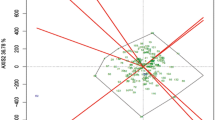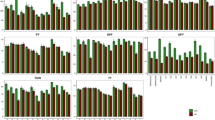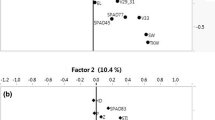Abstract
Assessment of quantitative traits in bi-parental progenies provides a strategy to identify drought tolerant genotypes and stress-adaptive traits in wheat. A recombinant inbred line (RIL) population with 167 lines produced from the SeriM82/Babax cross was subjected to normal irrigation and drought stress (at the heading stage) under field conditions. The study was done in Bajgah, Shiraz, Fars province, Iran, during three consecutive seasons. Shiraz is located in a temperate, major wheat production region of Iran that is prone to periodic drought. The aims of this study were to identify drought tolerant RILs and drought adaptive traits. The mean grain yield was 237.91 and 148.60 g m−2 under normal irrigation and drought stressed conditions, respectively. Above 48.0% reduction in grain yield was observed under drought stress in the three consecutive growing seasons. Several RIL lines had high grain yield under both moisture regimes. The mean leaf relative water content (RWC) was 0.4 under drought condition. One RIL had relatively high RWC and grain yield under both treatments. Heritability of several traits did not change between the two moisture conditions whereas it was reduced for few of traits. Assessment of the interrelationship of traits showed that RWC, days to heading, awn length and spikelets per spike were the main contributors to grain yield that became more important under drought conditions. Given the relatively high heritability values estimated under both conditions and strong association with grain yield, these drought adaptive traits could be used for indirect selection to improve drought tolerance in this region of Iran. Overall, information of the identified drought adaptive traits and RILs lay foundation for the improvement of drought tolerance in wheat.


Similar content being viewed by others
References
Ahmadi A, Emam Y, Pessarakli M (2010) Biochemical changes in maize seedlings exposed to drought stress conditions at different nitrogen levels. J Plant Nutr 33:541–556
Ayer DK, Sharma A, Ojha BR, Paudel A, Dhakal K (2017) Correlation and path coefficient analysis in advanced wheat genotypes. SAARC J Agric 15:1–12
Barrs HD, Weatherley PE (1962) A re-examination of the relative turgidity technique for estimating water deficits in leaves. Aust J Biol Sci 15:413–428
Blum A, Sullivan CY, Nguyen H (1997) The effect of plant size on wheat response to agents of drought stress. II. Water deficit, heat and ABA. Funct Plant Biol 24:43–48
Bogale A, Tesfaye K, Geleto T (2011) Morphological and physiological attributes associated to drought tolerance of Ethiopian durum wheat genotypes under water deficit condition. J Biodivers Environ Sci 1:22–36
Chapman SC, Crossa J, Edmeades GO (1997) Genotype by environment effects and selection for drought tolerance in tropical maize. I. Two mode pattern analysis of yield. Euphytica 95:01–09
Clarke JM, McCAIG TN (1982) Excised-leaf water retention capability as an indicator of drought resistance of Triticum genotypes. Can J Plant Sci 62:571–578
Fellahi Z, Hannachi A, Bouzerzour H, Boutekrabt A (2013) Correlation between traits and path analysis coefficient for grain yield and other quantitative traits in bread wheat under semi arid conditions. J Agric Sust 3(1):16–26
Fernandez GC (1992) Effective selection criteria for assessing plant stress tolerance. Adapt Food Crops Temp Water Stress 13:181992257270
Fischer RA (1985) Physiological limitations to producing wheat in semitropical and tropical environments and possible selection criteria. In Symposium on wheats for more tropical environments, Mexico, DF (Mexico), 24–28 Sept 1984. CIMMYT
Gelalcha S, Hanchinal RR (2013) Correlation and path analysis in yield and yield components in spring bread wheat (Triticuma estivum L.) genotypes under irrigated condition in Southern India. Afr J Agric Res 8(24):3186–3192
Gupta NK, GuptaS KA (2001) Effect of water stress on physiological attributes and their relationship with growth and yield of wheat cultivars at different stages. J Agron Crop Sci 186:55–62
Holland JB, Nyquist WE, Cervantes-Martínez CT (2003) Estimating and interpreting heritability for plant breeding: an update. Plant Breed Rev 22:9–112
Kearsey M, Pooni HS (2004) The genetical analysis of quantitative traits, 2nd edn. Chapman and Hall, Boca Raton
Khamssi NN, Najaphy A (2012) Comparison of photosynthetic components of wheat genotypes under rain-fed and irrigated conditions. Photochem Photobiol 88:76–80. https://doi.org/10.1111/j.1751-1097.2011.01008.x
Law CN, Snape JW, Worland AJ (1978) The genetical relationship between height and yield in wheat. Heredity 40:133. https://doi.org/10.1038/hdy.1978.13
Leilah AA, Al-Khateeb SA (2005) Statistical analysis of wheat yield under drought conditions. J Arid Environ 61:483–496
Lopes MS, Reynolds MP, Jalal-Kamali MR, Moussa M, Feltaous Y, Tahir ISA, Barma N, Vargas M, Mannes Y, Baum M (2012) The yield correlations of selectable physiological traits in a population of advanced spring wheat lines grown in warm and drought environments. Field Crops Res 128:129–136
Lopes MS, Reynolds MP, McIntyre CL, Mathews KL, Kamali MJ, Mossad M, Feltaous Y, Tahir IS, Chatrath R, Ogbonnaya F, Baum M (2013) QTL for yield and associated traits in the Seri/Babax population grown across several environments in Mexico, in the West Asia, North Africa, and South Asia regions. Theor Appl Genet 126:971–984
Mathews KL, Malosetti M, Chapman S, McIntyre L, Reynolds M, Shorter R, van Eeuwijk F (2008) Multi-environment QTL mixed models for drought stress adaptation in wheat. Theor Appl Genet 117:1077–1091
McIntyre CL, Mathews KL, Rattey A, Chapman SC, Drenth J, Ghaderi M, Reynolds M, Shorter R (2010) Molecular detection of genomic regions associated with grain yield and yield-related components in an elite bread wheat cross evaluated under irrigated and rainfed conditions. Theor Appl Genet 120:527–541
Mir RR, Zaman-Allah M, Sreenivasulu N, Trethowan R, Varshney RK (2012) Integrated genomics, physiology and breeding approaches for improving drought tolerance in crops. Theor Appl Genet 125:625–645
Mohammadi R, Abdulahi A (2017) Evaluation of durum wheat genotypes based on drought tolerance indices under different levels of drought stress. J Agric Sci 62:1–14
Mohammadi R, Haghparast R, Amri A, Ceccarelli S (2010) Yield stability of rainfed durum wheat and GGE biplot analysis of multi-environment trials. Crop Past Sci 61:92–101
Olivares-Villegas JJ, Reynolds MP, McDonald GK (2007) Drought-adaptive attributes in the Seri/Babax hexaploid wheat population. Funct Plant Biol 34:189–203
Ortiz R, SayreKD GB, Gupta R, Subbarao GV, Ban T, Hodson Dixon JM, Ortiz-Monasterio JI, Reynolds M (2008) Climate change: can wheat beat the heat? Agric Ecosyst Environ 126:46–58
Payne RW, Harding SA, Murray DA, Soutar DM, Bird DB (2012) The 12 guide to the GenStat Release 15. VSN International, Hemel Hempstead
Pinto RS, Reynolds MP, Mathews KL, McIntyre CL, Olivares-Villegas JJ, Chapman SC (2010) Heat and drought adaptive QTL in a wheat population designed to minimize confounding agronomic effects. Theor Appl Genet 121:1001–1021
Pinto RS, Lopes MS, Collins NC, Reynolds MP (2016) Modelling and genetic dissection of staygreen under heat stress. Theor Appl Genet 129(11):2055–2074
Pradhan GP, Prasad PV, Fritz AK, Kirkham MB, Gill BS (2012) Effects of drought and high temperature stress on synthetic hexaploid wheat. Funct Plant Biol 39:190–198
Rattey A, Shorter R, Chapman S, Dreccer F, van Herwaarden A (2009) Variation for and relationships among biomass and grain yield component traits conferring improved yield and grain weight in an elite wheat population grown in variable yield environments. Crop Past Sci 60:717–729
Reynolds M, Manes Y, Izanloo A, Langridge P (2009) Phenotyping approaches for physiological breeding and gene discovery in wheat. Ann Appl Biol 155(3):309–320
Reynolds M, Manes Y, Rebetzke G (2012) Application of physiology in breeding for heat and drought stress. In Reynolds M, Pask A, Mullan D (eds) Physiological breeding. I: Interdisciplinary approaches to improve crop adaptation. CIMMYT, Mexico
Riaz R, Chowdhry MA (2003) Genetic analysis of some economic traits of wheat under drought condition. Asian J Plant Sci 2:790–796
Saini HS, Westgate ME (1999) Reproductive development in grain crops during drought. Adv Agric 68:59–96
SAS (2004) SAS version 9.2. SAS Institute Inc SAS Online Doc 913 SAS Institute Inc., Cary, NC
Siddique KHM, Belford RK, Perry MW, Tennant D (1989) Growth, development and light interception of old and modern wheat cultivars in a Mediterranean-type environment. Aust J Agric Res 40:473–487
SohrabiChah-Hassan F, Soluki M, Fakhri BA, Masoudi B (2018) Mapping QTLs for physiological and biochemical traits related to grain yield under control and terminal heat stress conditions in bread wheat (Triticum aestivum L.). Physiol Mol Biol Plants 24(6):2
Tahmasebi S, Heidari B, Pakniyat H, Jalal Kamali MR (2014) Independent and combined effects of heat and drought stress in the SeriM82 × Babax bread wheat population. Plant Breed 133:702–711
Tahmasebi S, Heidari B, Pakniyat H, Dadkhodaie A (2015) Consequences of 1BL/1RS translocation on agronomic and physiological traits in wheat. Cereal Res Commun 43:554–566
Tahmasebi S, Heidari B, Pakniyat H, McIntyre CLM (2017) Mapping QTLs associated with agronomic and physiological traits under terminal drought and heat stress conditions in wheat (Triticum aestivum L.). Genome 60:26–45
Tammam AA, Alhamd MA, Hemeda MM (2008) Study of salt tolerance in wheat (Triticum aestivum L.) cultivar Banysoif 1. Aust J Crop Sci 1:115–125
Teulat B, Zoumarou-Wallis N, Rotter B, Salem MB, Bahri H, This D (2003) QTL for relative water content in field-grown barley and their stability across Mediterranean environments. Theor Appl Genet 108:181–188
Trethowan RM, Reynolds M (2007) Drought resistance: genetic approaches for improving productivity under stress. In: Buck HD, Nisi JE, Salomon N (eds) Wheat production in stressed environments. Springer, Berlin, pp 289–299
Tricker PJ, Ehabti A, Schmidt J, Fleury P (2018) The physiological and genetic basis of combined drought and heat tolerance in wheat. J Exp Bot 69(13):3195–3210
Villareal RL, Bañuelos O, Mujeeb-Kazi A, Rajaram S (1998) Agronomic performance of chromosomes 1B and T1BL. 1RS near-isolines in the spring bread wheat Seri M82. Euphytica 103:195–202
Villegas D, Aparicio N, Blanco R, Royo C (2001) Biomass accumulation and main stem elongation of durum wheat grown under Mediterranean conditions. Ann Bot 88:617–627
Wardlaw IF, Willenbrink J (1994) Carbohydrate storage and mobilisation by the culm of wheat between heading and grain maturity: the relation to sucrose synthase and sucrose-phosphate synthase. Funct Plant Biol 21:255–271
Xue GP, McIntyre CL, Jenkins CLD, Glassop D, van Herwaarden AF, Shorter R (2008) Molecular dissection of variation in carbohydrate metabolism related to water-soluble carbohydrate accumulation in stems of wheat. Plant Physiol 146:441–454
Yadav RS, Hash CT, Bidinger FR, Devos KM, Howarth CJ (2004) Genomic regions associated with grain yield and aspects of post-flowering drought tolerance in pearl millet across stress environments and tester background. Euphytica 136:265–277
Acknowledgements
The authors gratefully acknowledge Dr. Matthew P. Reynolds and Marta S. Lopes of CIMMYT, and Dr. Lynne McIntyre of CSIRO Agriculture and Food for providing seed and information on the Seri M82/Babax population.
Author information
Authors and Affiliations
Corresponding author
Additional information
Publisher's Note
Springer Nature remains neutral with regard to jurisdictional claims in published maps and institutional affiliations.
Rights and permissions
About this article
Cite this article
Sobhaninan, N., Heidari, B., Tahmasebi, S. et al. Response of quantitative and physiological traits to drought stress in the SeriM82/Babax wheat population. Euphytica 215, 32 (2019). https://doi.org/10.1007/s10681-019-2357-x
Received:
Accepted:
Published:
DOI: https://doi.org/10.1007/s10681-019-2357-x




